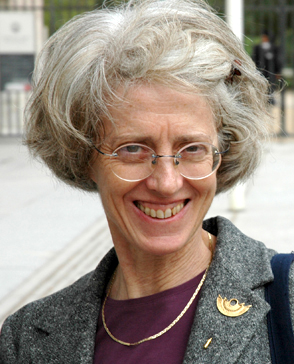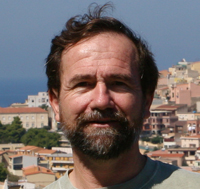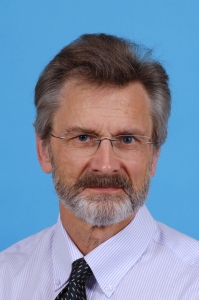Uncategorised
Barry Lee
 Professor Lee is an innovative multidisciplinary scientist who has an extraordinary record of productivity. He has made significant contributions to our understanding of basic coding mechanisms in visual processing and is recognized for his efforts at bridging the gap between psychophysics and physiology. In addition, through collaborative efforts, he has been at the center of the great advances that have been made in the last 20 years in unraveling the relations between structure and visual function in the retina. Finally, the Society recognizes his long-term service to the society, as member of the board of directors, meeting organizer and proceedings editor.
Professor Lee is an innovative multidisciplinary scientist who has an extraordinary record of productivity. He has made significant contributions to our understanding of basic coding mechanisms in visual processing and is recognized for his efforts at bridging the gap between psychophysics and physiology. In addition, through collaborative efforts, he has been at the center of the great advances that have been made in the last 20 years in unraveling the relations between structure and visual function in the retina. Finally, the Society recognizes his long-term service to the society, as member of the board of directors, meeting organizer and proceedings editor.
Jerry Jacobs
 Over the last 45 years, Professor Gerald H. Jacobs has authored more than 200 papers related to color vision. His discoveries have provided a basis for understanding the underpinnings of human color vision within the larger context of the evolution of the mammalian visual system. Professor Jacobs is a member of the Neuroscience Research Institute and the Department of Psychology at the University of California in Santa Barbara, where he has taken an interdisciplinary approach to characterizing the nature and distribution of the cone photopigments within and across mammalian species and understanding how variations in photoreceptor complement relate to differences in color vision capacity. Widely recognized as a leader among his generation of vision scientists, Professor Jacobs has been an inspiring mentor for generations of scientists who have shared his passion for understanding the diversity color vision in our world.
Over the last 45 years, Professor Gerald H. Jacobs has authored more than 200 papers related to color vision. His discoveries have provided a basis for understanding the underpinnings of human color vision within the larger context of the evolution of the mammalian visual system. Professor Jacobs is a member of the Neuroscience Research Institute and the Department of Psychology at the University of California in Santa Barbara, where he has taken an interdisciplinary approach to characterizing the nature and distribution of the cone photopigments within and across mammalian species and understanding how variations in photoreceptor complement relate to differences in color vision capacity. Widely recognized as a leader among his generation of vision scientists, Professor Jacobs has been an inspiring mentor for generations of scientists who have shared his passion for understanding the diversity color vision in our world.
Steven Shevell
 For over 35 years, Professor Shevell has contributed to the vision and particularly the color vision community in breaking new ground in research, training new researchers and providing service to the community. In his experimental work, he has carefully integrated theoretical and experimental approaches in studies of how early mechanisms and context influence color perception. He has artfully exploited the technique of hue cancellation to study adaptive processes, spatio-temporal constraints, memory and binocular integration in color perception. Professor Shevell is the Eliakim Hastings Moore Distinguished Service Professor in the Department of Psychology at The University of Chicago, Professor in the Section of Ophthalmology and Visual Science, Department of Surgery, and in the Committee on Computational Neuroscience, and, also, immediate-past Chair of the Integrative Neuroscience Graduate Program. In addition, he has served, over the years, on editorial boards of leading journals, review panels of leading granting agencies and on the boards of major research societies. He is currently a member of the Directors' Committee of the ICVS. His wise and equilibrated advice is sought after in our deliberations and personifies the voice of careful research, integrity and reason.
For over 35 years, Professor Shevell has contributed to the vision and particularly the color vision community in breaking new ground in research, training new researchers and providing service to the community. In his experimental work, he has carefully integrated theoretical and experimental approaches in studies of how early mechanisms and context influence color perception. He has artfully exploited the technique of hue cancellation to study adaptive processes, spatio-temporal constraints, memory and binocular integration in color perception. Professor Shevell is the Eliakim Hastings Moore Distinguished Service Professor in the Department of Psychology at The University of Chicago, Professor in the Section of Ophthalmology and Visual Science, Department of Surgery, and in the Committee on Computational Neuroscience, and, also, immediate-past Chair of the Integrative Neuroscience Graduate Program. In addition, he has served, over the years, on editorial boards of leading journals, review panels of leading granting agencies and on the boards of major research societies. He is currently a member of the Directors' Committee of the ICVS. His wise and equilibrated advice is sought after in our deliberations and personifies the voice of careful research, integrity and reason.
Françoise Viénot
 Trained as a physicist, Professor Francoise Vienot was introduced to the mysteries of colour science by Yves Le Grand and she has carried forward his distinguished tradition. Her early work was on colorimetry: she was especially concerned with individual differences in colour matches, before the topic had become as fashionable as it later became. Her mastery of colorimetry led her to the work for which she is best known in the wider world: she developed an algorithm for simulating for the normal eye the appearance of scenes for the dichromat. This algorithm has found many practical applications, including an application for the iPhone that allows the user in real time to inspect the world as it appears to a protanope or deuteranope. Professor Vienot has contributed to many other aspects of colour science. She has published historical research on the colour system of Chevreul. She has published a textbook on colour science, as well as important papers on Maxwell's spot and macular pigment, on mesopic photometry, on the perception of gloss, and on the Benham-Fechner colours. She has a talent to take applied problems and use them to inspire fundamental research. For most of her career, Francoise Vienot has been based at the Museum National d'Histoire Naturelle; and this has had interesting influences on her science. She is an expert on plant pigments and is an authority on horticultural colours. The Museum brought her into contact with ecologists, a collaboration that led to the first experimental paper on the fruit signals that trees present to their disseminators. For nearly 20 years, she has marshalled all her considerable tact, patience and precision to bring to its conclusion CIE Technical Committee 1-36, which has prepared a physiologically based system of colorimetry. To our own Society, and to the IRGCVD from which it evolved, she has been an active and loyal contributor since 1974.
Trained as a physicist, Professor Francoise Vienot was introduced to the mysteries of colour science by Yves Le Grand and she has carried forward his distinguished tradition. Her early work was on colorimetry: she was especially concerned with individual differences in colour matches, before the topic had become as fashionable as it later became. Her mastery of colorimetry led her to the work for which she is best known in the wider world: she developed an algorithm for simulating for the normal eye the appearance of scenes for the dichromat. This algorithm has found many practical applications, including an application for the iPhone that allows the user in real time to inspect the world as it appears to a protanope or deuteranope. Professor Vienot has contributed to many other aspects of colour science. She has published historical research on the colour system of Chevreul. She has published a textbook on colour science, as well as important papers on Maxwell's spot and macular pigment, on mesopic photometry, on the perception of gloss, and on the Benham-Fechner colours. She has a talent to take applied problems and use them to inspire fundamental research. For most of her career, Francoise Vienot has been based at the Museum National d'Histoire Naturelle; and this has had interesting influences on her science. She is an expert on plant pigments and is an authority on horticultural colours. The Museum brought her into contact with ecologists, a collaboration that led to the first experimental paper on the fruit signals that trees present to their disseminators. For nearly 20 years, she has marshalled all her considerable tact, patience and precision to bring to its conclusion CIE Technical Committee 1-36, which has prepared a physiologically based system of colorimetry. To our own Society, and to the IRGCVD from which it evolved, she has been an active and loyal contributor since 1974.
Jack Werner
 Professor Werner received his Ph.D. from Brown University under the supervision of Professor Billy Wooten in the Walter S. Hunter Laboratory of Psychology. He conducted postdoctoral research with Professor Jan Walraven at the Institute for Perception - TNO in Soesterberg, The Netherlands. He was a member of the Psychology faculty at the University of Colorado, Boulder and is presently a Distinguished Professor of Ophthalmology at the University of California Davis where also holds appointments in Vision Science, and Neurobiology, Physiology & Behavior.
Professor Werner received his Ph.D. from Brown University under the supervision of Professor Billy Wooten in the Walter S. Hunter Laboratory of Psychology. He conducted postdoctoral research with Professor Jan Walraven at the Institute for Perception - TNO in Soesterberg, The Netherlands. He was a member of the Psychology faculty at the University of Colorado, Boulder and is presently a Distinguished Professor of Ophthalmology at the University of California Davis where also holds appointments in Vision Science, and Neurobiology, Physiology & Behavior.
An active member of ICVS and of it predecessor, IRGCVD, he is also a fellow of the American Association for the Advancement of Science, American Psychological Association, American Psychological Society, Association for Research in Vision and Ophthalmology, the Gerontological Society of America and the Optical Society of America. He received the Pisart Vision Award from Lighthouse International and he presented the University of Colorado, Boulder distinguished research lecture and the Optical Society of America Robert M. Boynton lecture.
He has made important contributions to our knowledge of the development and aging of color mechanisms using psychophysics, VEP's and most recently optical imaging techniques, OCT and adaptive optics. He has contributed to our understanding of the processes of aging in perception particularly as they relate to plasticity and potential clinical applications. Throughout his career he has maintained an active interest in opponent color mechanisms, color in art and color illusions.
A generation of vision scientists has enjoyed the benefits of reading the many books he has coedited. These include, Visual Perception: The Neurophysiological Foundations, Color Vision: Perspectives from Different Disciplines, The Visual Neurosciences , and The New Visual Neurosciences, which like Professor Werner's own research have brought together discoveries from anatomy, physiology and psychophysics to illuminate fundamental mechanisms underlying human perception.
David Foster

Prof. Foster’s distinguished career epitomizes the multidisciplinary nature of vision research. It began at Imperial College, London where he studied physics and went on to do a Ph.D. in vision with W. D. Wright in the Applied Optics Section. He subsequently held posts at Imperial College (Department of Physics), Keele University (Department of Communication and Neuroscience), Aston University (Department of Vision Sciences), and the University of Manchester (initially in the Institute of Science and Technology, Department of Optometry and Neuroscience). He is currently Professor of Vision Systems and Director of Research in the School of Electrical and Electronic Engineering at the University of Manchester.He is a fellow of the Institute of Physics and the Optical Society of America.
Prof. Foster’s research has advanced our understanding of colour vision for over 35 years. His studies of colour constancy report landmark discoveries. The breadth of his contributions includes work on rod-cone interactions, colour vision deficiency, colour perception of natural scenes and hyperspectral imaging. In addition to his own research, he has tirelessly nurtured the entire field of visual science, most notably as a co-founder and longtime editor-in-chief of Spatial Vision and as an editor, senior editor and since 2013 the editor-in-chief of Vision Research.
Michael Webster
 Professor Webster’s interest in color vision is rooted in his undergraduate work at the University of California, San Diego. He went on to a Ph.D. in Psychology at the University of California, Berkeley and then was a postdoctoral research fellow at the University of Cambridge, UK. In 1994 he joined the faculty at the University of Nevada, Reno, where he rapidly rose to a Foundation Professorship in the Department of Psychology with affiliations to graduate programs in Cognitive & Brain Sciences and Integrative Neuroscience, which he helped found and co-directs. He is a fellow of the Optical Society of America.
Professor Webster’s interest in color vision is rooted in his undergraduate work at the University of California, San Diego. He went on to a Ph.D. in Psychology at the University of California, Berkeley and then was a postdoctoral research fellow at the University of Cambridge, UK. In 1994 he joined the faculty at the University of Nevada, Reno, where he rapidly rose to a Foundation Professorship in the Department of Psychology with affiliations to graduate programs in Cognitive & Brain Sciences and Integrative Neuroscience, which he helped found and co-directs. He is a fellow of the Optical Society of America.
His research on color vison includes a steady stream of influential papers over the past 30 years. Two themes recur over the decades: adaptation and individual differences. His novel adaptation designs have advanced our understanding of the multiple pathways that mediate color perception, including color constancy and changes across the life span. The comprehensive breadth of his work on individual differences encompasses color matching, unique hues and color naming. Professor Webster is a beloved teacher and mentor. He has made also exceptional contributions to his peers and the field by serving on NSF and NIH grant review panels, as an editor of Vision Research, as the color vision editor for the Journal of the Optical Society of America A, and as chair of the Color Technical Group of the Optical Society of America. He recently was elected to the board of directors of both the Vision Sciences Society and ICVS, reflecting the high regard of his colleagues.
